 Open Access
Open Access
ARTICLE
WiMA: Towards a Multi-Criterion Association in Software Defined Wi-Fi Networks
1 Department of Electrical Engineering, Mirpur University of Science and Technology (MUST), Mirpur-10250 (AJK), Pakistan
2 Faculty of Electronics, Telecommunications and Informatics, Gdansk University of Technology, 80-233 Gdansk, Poland
3 Department of Computer Engineering, College of Computing and Informatics, University of Sharjah, Sharjah, 27272, United Arab Emirates
4 National University of Sciences and Technology (NUST), Islamabad, 44000, Pakistan
5 Department of Computer Science, HITEC University, Taxila, Pakistan
6 Computer Sciences Department, College of Computer and Information Sciences, Princess Nourah bint Abdulrahman University, Riyadh, 11671, Saudi Arabia
7 College of Computer Engineering and Sciences, Prince Sattam bin Abdulaziz University, Al-Kharj, Saudi Arabia
8 Department of Computer Science, Hanyang University, Seoul, 04763, Korea
9 Center for Computational Social Science, Hanyang University, Seoul, 04763, Korea
* Corresponding Author: Byoungchol Chang. Email:
Computers, Materials & Continua 2023, 75(2), 2347-2363. https://doi.org/10.32604/cmc.2023.034044
Received 05 July 2022; Accepted 02 September 2022; Issue published 31 March 2023
Abstract
Despite the planned installation and operations of the traditional IEEE 802.11 networks, they still experience degraded performance due to the number of inefficiencies. One of the main reasons is the received signal strength indicator (RSSI) association problem, in which the user remains connected to the access point (AP) unless the RSSI becomes too weak. In this paper, we propose a multi-criterion association (WiMA) scheme based on software defined networking (SDN) in Wi-Fi networks. An association solution based on multi-criterion such as AP load, RSSI, and channel occupancy is proposed to satisfy the quality of service (QoS). SDN having an overall view of the network takes the association and reassociation decisions making the handoffs smooth in throughput performance. To implement WiMA extensive simulations runs are carried out on Mininet-NS3-Wi-Fi network simulator. The performance evaluation shows that the WiMA significantly reduces the average number of retransmissions by 5%–30% and enhances the throughput by 20%–50%, hence maintaining user fairness and accommodating more wireless devices and traffic load in the network, when compared to traditional client-driven (CD) approach and state of the art Wi-Balance approach.Keywords
The rapid increase in smart devices and applications is due to the simple technical implementation and low cost of IEEE 802.11 networks [1]. Indoor connectivity of smart devices to the internet relies on Wi-Fi networks. Wi-Fi networks are easy to install leading to the unplanned installation of the APs and hence causing contention in the wireless transmission of packets [2]. Wi-Fi networks operate in an unlicensed spectrum making them more vulnerable to interference, especially from deployments in the same region due to many co-existing channels in the 2.4 GHz range [3]. The density of APs in the same region led to throughput degradation, increasing with the number of APs. The need for densification is also required when a single AP can cover the needs of increasing users in the same vicinity [4]. When the APs are increased the transmission power needs to be decreased to offload the overloaded APs as depicted in Fig. 1. High density Wi-Fi networks further degrade the throughput performance and thus require a more sophisticated method to address the aforementioned issues related to the fairness of load among the APs.
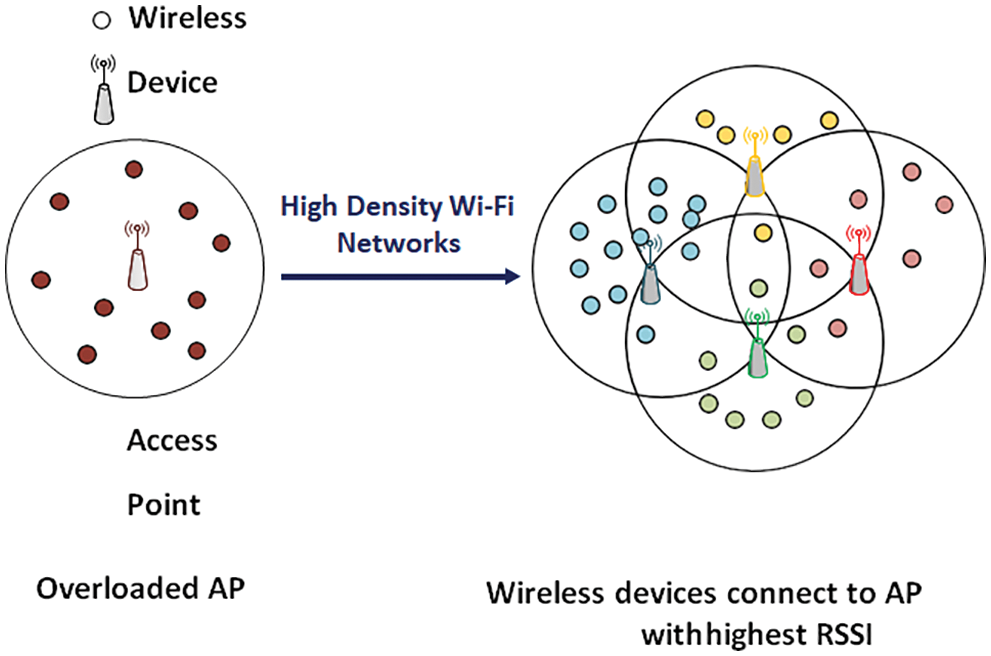
Figure 1: High density Wi-Fi networks
The association methods of wireless devices to the APs play an important role to determine how efficient are the management policies at the air interface [5]. The association procedure is not defined by the IEEE standards and such decisions are left to the vendors [6]. Most of the vendors follow the client-driven (CD) methods which are based on the RSSI values. In the CD, the association decisions are taken by the wireless devices and the AP with the highest RSSI value is chosen as the destination AP. However, just relying on a single metric for association does not guarantee optimal performance [7]. Other criteria such as noise and interference in the wireless medium together with the load of the network should also be considered. Fairness of load among the APs is a key performance indicator for optimal network performance [8]. The degradation of throughput becomes, even more, worse when the load on the single AP increases due to the increased number of wireless devices. The user distribution in Wi-Fi networks is mostly uneven if we think of applications such as campus networks, shopping malls, airports, and hospitals [9]. In the densification of the Wi-Fi networks, some of the APs become overloaded while the rest remain underloaded. Due to the uneven distribution of the load, it is obvious that instead of installing new resources we can use the free resources already present in the network. The fairness of load among the network resources is achieved by taking the load from the overloaded APs and distributing it among the underloaded APs. The approach leads to a cheap solution for managing a large number of users in dense Wi-Fi networks.
In recent years a new paradigm, software defined networking (SDN) has evolved to simplify the network complexities [10]. Networking programming abstractions are achieved in SDN by decoupling the data plane and the control plane [11]. The centralized controller in the control plane has the overall view of the network making it simple for the administrator to install or delete network policies adaptively. The controller gathers the information of the forwarding devices from the data plane in real time and makes decisions regarding mobility management, load balancing, routing policies, fault detection, and remedies. The controller is also capable of making network-wide decisions based on the data it received from the data plane through the OpenFlow protocol [12]. Numerous works have been done on SDN taking into account both wired and wireless networks [13]. In traditional Wi-Fi networks, the level of coordination between the APs and the network is almost zero [14]. The information related to the load of the APsTo is limited to network resources. On the other hand, the SDN controller sits in the control plane and takes efficient decisions regarding the associations and re-associations [15]. In the cases where the load is unevenly distributed among the APs, the SDN controller takes association and re-association decisions by manipulating the load reports it acquires from the data plane. The use of underloaded resources eradicates the need to install new infrastructure. Considering two APs in the same basic service set (BSS), the collisions cannot be reduced by just checking the load of the APs [16]. To reduce the packet collisions in the wireless medium, APs load along with channel occupancy and signal strength also play an important role. Reduced signal strength means more retransmissions with a lower physical rate keeping the channel busy for a longer period hence wasting resources.
In this paper, we present a novel technique WiMA, a multi-criterion technique that enhances the association mechanism in software defined Wi-Fi networks (SD-Wi-Fi). WiMA considers all important factors needed for the association hence avoiding the need for densification of Wi-Fi networks. The proposed scheme estimates the channel load efficiently by monitoring the transmitted rates and transmitted data periodically. WiMA also provides a solution to the case when the number of wireless devices increases abruptly, and the need for densification is a must. WiMA considers three main factors to reduce densification and installation of new infrastructure, namely wireless AP Load, channel occupancy, and RSSI. The proposed solution addresses the collision domain problems by considering the airtime in the channel rather than the airtime used by the single AP. The RSSI levels are considered so that the physical rate is not degraded. WiMA is designed as the solution for the densification of Wi-Fi networks when the number of wireless devices and wireless traffic load increase for the same amount of network resources. Considering the multi-criterion solution in WiMA a tradeoff of optimal performance is achieved. WiMA when compared to the traditional and state-of-the-art approaches, exhibits improved network resource allocation. All the issues and important aspects of a dense Wi-Fi network are addressed and considered respectively. To the best of our knowledge, WiMA is the first solution providing guaranteed optimal throughput performance during the associations of wireless devices to the APs. The core contributions of the proposed work are given below:
i) Optimal throughput performance is achieved by considering a multi-criterion for association in SD-Wi-Fi rather than by just focusing on one parameter, i.e., RSSI. WiMA not only enhances the network resource utilization but also considers the resources that are wasted during collisions or interference.
ii) WiMA induces SDN to introduce programmability in the traditional Wi-Fi networks so that the hardware does not need to be changed thus saving the cost. Moreover, the SDN controller allows the network administrator to take better association decisions as it has the overall view of the network thus gaining efficiency over distributed methods.
iii) Seamless handovers are incorporated by using WiMA, guaranteeing optimal throughput during handoffs and better resource allocation. Channel congestion on the other hand is avoided by considering the channel airtime rather than the airtime of a single AP.
The remainder of this paper is organized as follows. Section 2 explores the related work. The proposed WiMA approach is discussed in Section 3. The performance evaluation is presented in Section 4. Finally, the paper is concluded in Section 5.
In traditional Wi-Fi networks, the associations are made using client-driven approaches, where the wireless device initiates the handoff mechanism. Distributed approaches later became trendy before the evolution of SDN [16]. In the distributed approaches association decision is made by the wireless device itself considering the RSSI values and some performance degradation metrics in the network. Distributed algorithms are designed for association problems. The stations that miss the deadline for the association are re-associated with another AP in the dense Wi-Fi network scenario [17]. The distributed approaches outperform the client-driven approaches but as they lack the overall network view so they result in degraded network performance considering all the APs. The load among the APs could be shuffled by controlling the transmission power, which is commonly known as the cell breathing technique [18]. The reduced transmission power allows the APs to lose the wireless devices at the distance, resulting in the re-association of those devices to the nearby AP. The technique may sound easy, but the implementation is cumbersome. Using SDN can increase the flexibility of the Cell breathing technique. AP coverage techniques require an adaptive mechanism to work with the increasing number of associations which cost additional hardware and cost [19]. The seamless handovers require a re-association process where a certain wireless device may have no AP [20]. This waiting time leads to degraded throughput performance and any research work has been done to address this issue. The operation of APs on non-overlapping channels is a solution [21]. Seamless handovers can be accommodated using light virtual access points (LVAPs). The LVAPs allow a dedicated channel for each AP. The handoff mechanism is abstracted from the user who may continue to experience internet access. Load balancing at the APs is another method to ensure fairness of load among the networks [22]. The average load of the APs is used as a metric to shuffle the load among all APs whenever a new association is made. Researchers have also designed an algorithm to select the smart AP by using parameters such as the fitting function [23]. QoS is satisfied by using Markov chain models. The Markov models work to reduce re-transmission delays [24]. Algorithms are devised to address the mobility issues which in turn reduce the handover times. Methods have been studied to maintain AP thresholds [25]. Beyond the threshold levels, the APs do not accept new associations; however, this method limits the mobility of wireless devices.
Techniques are developed to shift the load from the overloaded APs to the least loaded ones. The APs report their load status to the controller and the controller makes the de-association and re-association decisions [26]. Considering the load of the single AP is not accurate as the number of other factors affects the channel conditions. Enterprise wireless local area networks (EWLANs) are deployed to study the number of users associated with a certain AP and the channel load of the certain AP [27]. This technique is not as accurate as other APs using the same medium could overload the channel and hence increase packet collisions leading to degradation of the throughput. Several research papers are published considering the association mechanism in IEEE 802.11 networks. The methods aim to achieve load balancing in the data plane and control plane [5]. The approach is effective if the collision domains are not considered. As the number of channels in a dense Wi-Fi network is limited so it is impossible to avoid the collision domains. It is important to consider the channel load and AP load for optimal network performance. The APs in dense Wi-Fi networks use the same collision domain so the airtime of one AP affects the airtime of the other AP. Research has been done where collision domains and APs load are considered together. Authors consider both AP load and channel load [28]. The only shortcoming of the technique is that the hardware needs to be changed at the user’s end. Specific channels are assigned to the APs manually by neglecting the collision domains [29]. It is important to know that collision domains cannot be avoided and hence the technique is not optimal.
The association mechanism also considers taking the bandwidth requirements. The bandwidth requirement of the wireless devices is taken as the main input. Load balancing among the APs is achieved by considering bandwidth fairness among the users [30]. The problem with the technique is that each user must specify its bandwidth requirement before the load balancing algorithm. The users associated with the APs are minimized by considering the bandwidth needed by each user [31]. The techniques have some drawbacks such as estimating the workload of the AP through several associated clients, which is not a true metric for estimating AP load. These techniques lead to ping-pong effects which are not easy to handle unless there is coordination among the APs. The ping-pong effect is addressed where the handoff is not initiated until the destination AP is chosen for n consecutive times [32]. The method creates artificial delays in the handoffs. Enhanced bandwidth allocation is made to users while keeping the load balanced at the APs [33]. The approach does not take into account the channel conditions and only considers improving a single parameter. The approaches are a good choice over CD approaches, but they do not address channel congestion or limit the collision domains.
Throughput maximization is another technique used by researchers to enhance the aggregated throughput of the network. The wireless devices connect to the AP through a static distribution to offer better performance [34]. Different network interfaces are selected to satisfy the QoS by the load balancing algorithm [35]. The best possible path for flows is selected to improve the jitter response. Graph theory is implemented to achieve throughput maximization by choosing the best association graph between the AP and the wireless device. The only condition is that all the APs need to share the same channel. A virtual resource chain is used to achieve maximum throughput. The throughput maximization techniques focus on a single parameter and do not consider utilizing underloaded resources due to collision or interference [36].
WiMA is a multi-criterion technique used for smooth associations in SD-Wi-Fi as depicted in Fig. 2. WiMA sits in the application plane and communicates with the SDN controller through an application programmable interface (APIs). The SDN controller is responsible to monitor the forwarding devices in the data plane through a southbound interface. The proposed WiMA aims to avoid the need for high density Wi-Fi networks where more APs are required. WiMA induces SDN technology to collect the RSSI reports and channel usage by APs. The SDN controller in collecting these reports uses three indicators for associations and re-associations: (1) The load of the APs; (2) channel occupancy; and (3) the RSSI values. WiMA re-associates wireless devices in such a manner that underloaded APs are utilized hence avoiding the need to install new infrastructure. Algorithm 1 presents the working flow for WiMA. Three values, minimum, maximum, and median are chosen as the threshold values. Whenever the aforementioned values are met, the indicator triggers an action. The process is repeated periodically whenever the AP reports the values to the controller. The periodicity is monitored by the controller. The minimum, maximum, and median values are not calculated at the instant; instead, the average of the previous 10 values is used. The average values are used to overcome the ping-pong effect as a single and instant value cannot have an impact to induce significant changes through the algorithm. The remaining sections highlight different indicators in detail. The association trigger mechanism is studied. The algorithm works for the best tradeoff between network resources and signal quality. The destination AP is chosen by [RSSIy (ChannelLoadAPx + APxLoad)]. Where x and y are AP and wireless device representation. As the RSSI is measured in a negative number line so the product taken is maximized. Higher signal quality is the least number of re-transmissions, leading to more free time for the channel. The algorithms summarize the best combination of the AP load and channel load. The algorithm takes the wireless devices as the tasks and APs as the agents. The best association of wireless devices to an AP that would maximize [RSSIy (ChannelLoadAPx + APxLoad)] is chosen. The problem is solved as a generalized assignment problem (GAP).
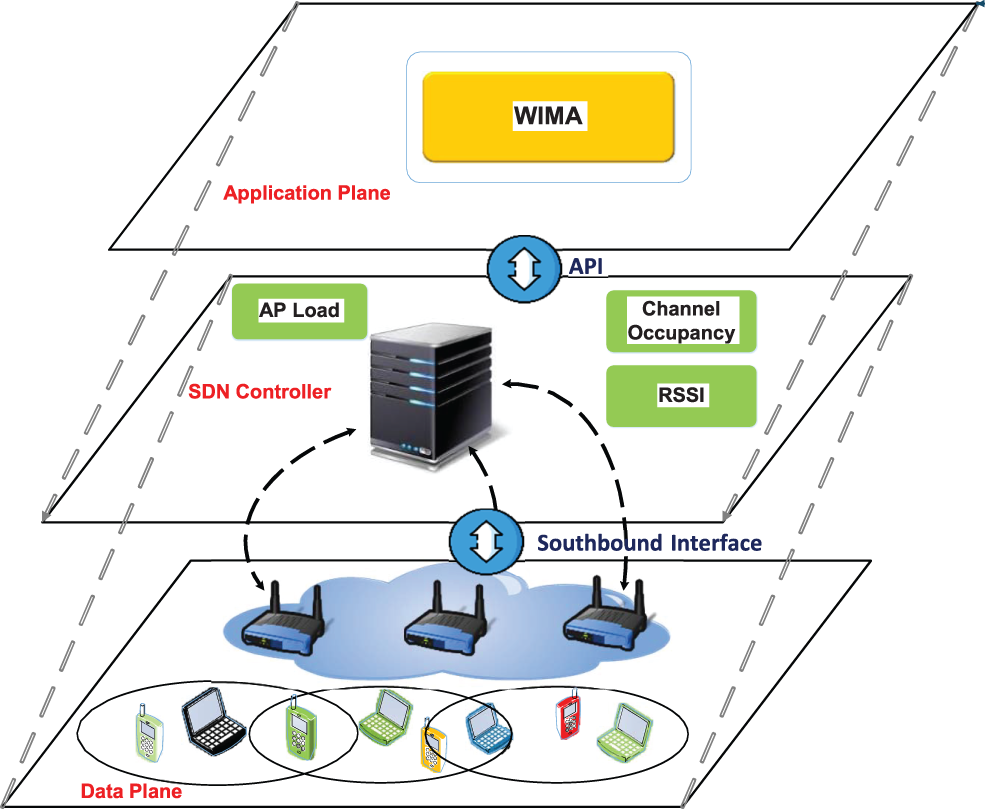
Figure 2: WiMA architecture
WiMA aims to reduce the overloaded APs situation. The best possible solution for the overloaded APs is to add another AP making the Wi-Fi network dense. The clients from the overloaded APs shift towards the new AP depending upon the RSSI values. This method is cumbersome and costly and will lead to collision domains as only a limited number of channels are available in IEEE 802.11 standard. Eventually, the congestion factor will come into play as the wireless traffic of one AP affects the other. To avoid installing the new infrastructure is very important. There can be a case when the wireless devices associated with an overloaded AP are shifted to an AP having lower RSSI values but good internet access. The CD approach has no standard steps to follow such practice as wireless devices will connect to the AP with the highest RSSI even if it is overloaded.
To have better resource utilization WiMA triggers its algorithm. WiMA aims to increase the airtime for the wireless devices but migrating them to underloaded APs in the vicinity and hence increasing the performance of the network. The load of the AP is measured using the channel occupancy metric as equated in Eq. (1). WiMA makes use of the delivery probabilities of each wireless device. The said probabilities with the Bytes transmitted are reported periodically to the controller so the channel occupancy with the best probability rate Pbest can be determined. This mathematical computation does not take into account the contention windows but yet it is powerful enough to compare the occupancies of different channels.

WiMA reduced the number of collision domains for APs. The channels are assigned adaptively seeing the number of associations. Channel Occupancy is a key indicator to do so. WiMA as discussed earlier not only eradicates the need for dense Wi-Fi networks but also mitigates its effects when a large number of wireless devices join the network. The overloaded channels are avoided for the APs working in the same domain. The channel occupancy is the combined effect of the channel itself and the occupancy caused by the APs working in the same collision domain. The channel assignment involves assigning the channels to the APs that are not used by the neighboring APs. If all the channels are in use in the worst-case scenario, the algorithm assigns the least loaded channel to the AP to reduce interference and collisions. Seeing the threshold values, if the channel load caused by the AP is beyond the limits the algorithms eradicate the channel from the list. It is always important to consider the channel load because in the opposite scenario the channel load will be redistributed keeping some of the channels still overloaded. The solution is not as efficient as optimal values, but it is still triggered when the other two indicators cannot handle the situation. An AP with less load is still affordable than a loaded channel.
In algorithm 1, the station needs to check all the APs before the best possible solution is met. The complexity of the algorithm is O(d w) where q is the total number of APs and w is the number of wireless devices. To avoid increasing complexity, the APs are sorted according to values of [RSSIy ∗ (ChannelLoadAPx + APxLoad)]. Algorithm 2 is called recursively by Algorithm. Algorithms 2 ensures that all APs have the channel assigned to them. On each recursion level, the AP remaining behind are sorted. The rearrangement considers the APs with the lowest number of available channels and the highest number of neighbors. If the number of APs is considered as d, then the complexity of Algorithm 2 is computed as O[d.log(d)]. The second step involves going through the list of APs so that the overlapping channels are removed. The complexity of this step is O(d). The next step is to go through the channels one by one which also has the complexity of O(d). As a result, all the recursive call takes O(d). The function iterates d − 1 time so the total complexity of Algorithm 2 is calculated to be O(n2) as T (d) = T (d − 1) + O(d). The overall complexity computed is O(d2).

The average RSSI of an AP is calculated by averaging all the RSSIs of the wireless devices to the AP. If the RSSI is lower, there will be more re-transmission and the channel will be occupied for a long. The wireless device redistribution also led to low RSSI values at some APs resulting in more frames being re-transmitted. RSSI serves as a very crucial indicator for the associations to take place leading to optimal network performance. The RSSI indicator allows WiMA to decide regarding associations and re-associations. When the RSSI values as received by the wireless device are poor, WiMA seeks better distribution of wireless devices among the APs such that the network performance is not altered.
There are several tools to evaluate the performance of wired networks, but very little help and guidance is available to simulate the performance of software defined wireless networks. There is a need for such tools. To simulate the performance of WiMA, we have used the Mininet-NS3-WiFi.
A Linux based platform employing Mininet Emulator is used to perform experiments related to SDN. There is complete support for OpenFlow switches in Mininet but very less support for wireless medium propagation. NS-3 is used in combination with Mininet to model a real-time channel for IEEE 802.11 networks. Mininet-NS-3-WiFi platform is developed to simulate WiMA. Real-time devices are appended to the simulation code using the real-time emulation mode in NS-3. The simulation clock and the emulation clock are aligned. Fig. 3 shows the connections of the virtual Mininet nodes in Mininet-NS-3-WiFi. TapBridge and NetDevice interfaces are used to support the connections. Mininet nodes have a unique network protocol stack and unique Linux name. Mininet node uses the Linux Tap NetDevice to connect to the NS-3 channel. NS-3 is connected to an external real-time interface through NetDevice by performing a simulation of the layer 2 network interface. Mininet-NS-3-WiFi has all the necessary libraries to evaluate the performance of SD-Wi-Fi. The record for total traffic generated by wireless devices is maintained by the Iperf server. The simulation parameters are listed in Table 1.
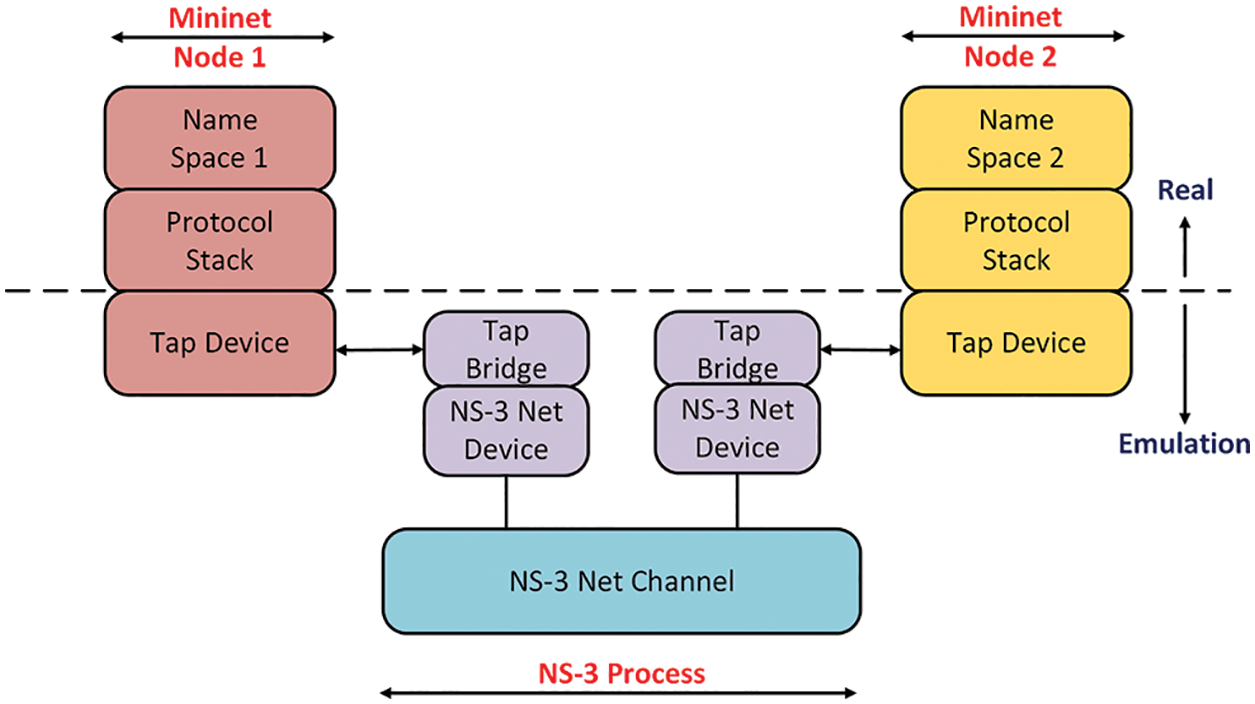
Figure 3: WiMA platform

In the experiment densification is created to shift the load from the overloaded APs to underloaded APs as shown in Fig. 4. WiMA aims to distribute the load among all the network resources. We have used channels 11, 6 and 1 to avoid the collision domain so that the wireless traffic of each AP does not affect the other. The concept of mobility is not taken into account so it is rather easy to understand the results. The experiment is done in two phases where the time for each phase is set to 10 min. In phase 1 only 20 wireless devices are transmitting whereas, in phase 2, 10 additional wireless devices are programmed to transmit. All the wireless stations are placed inside the coverage area of one AP so that WiMA helps to shift the load from one AP to another. Table 2 exhibits all the information related to channels, simulation time and wireless devices used in experimentation. Iperf server is used to measure the throughput achieved.
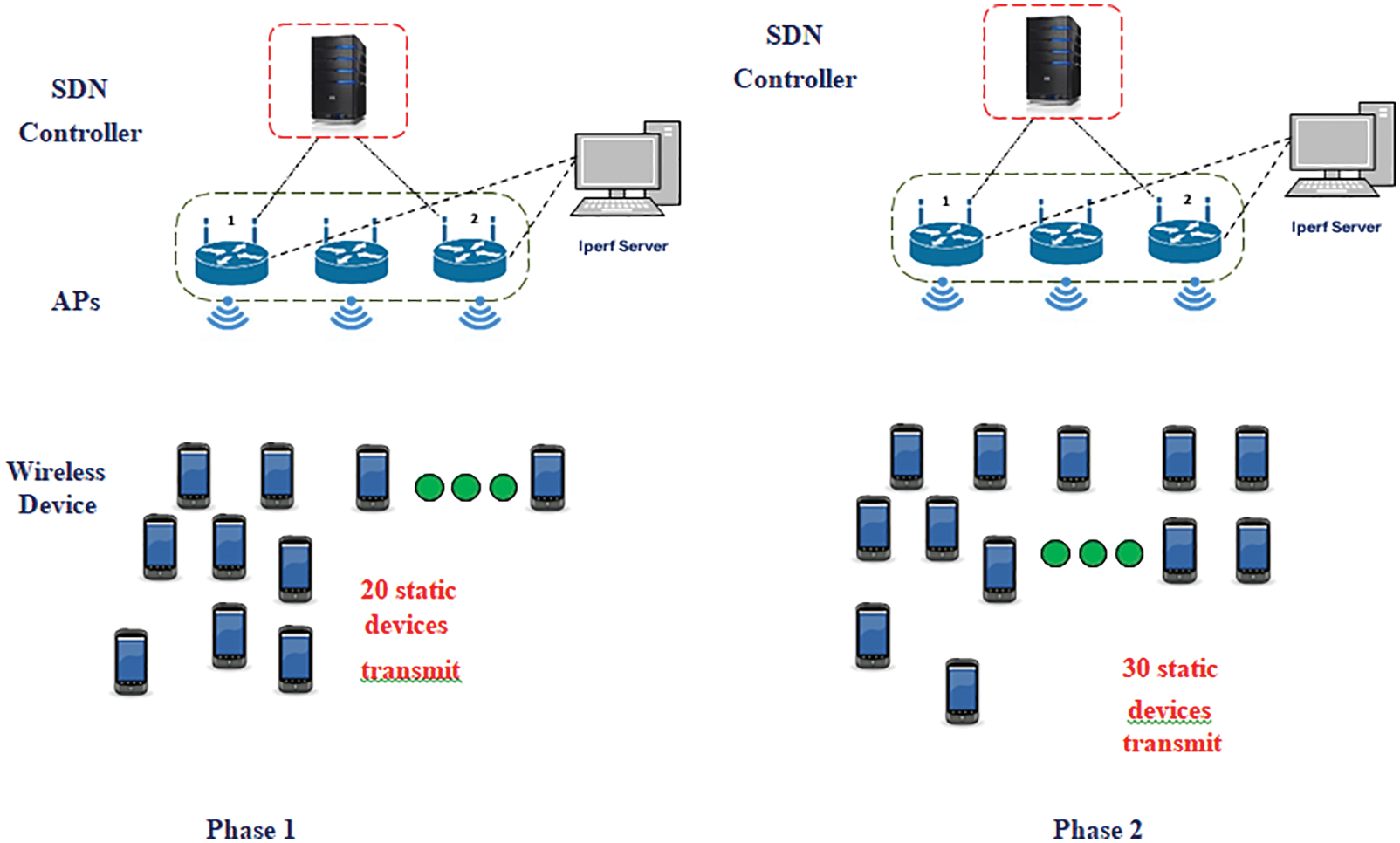
Figure 4: Experiment 1 illustration

Experiment number 2 is done to see how WiMA reacts to the change in the signal quality as shown in Fig. 5. Five moving wireless devices are used. The wireless devices are programmed to move in the coverage area of all three APs. The path is chosen to see the performance of RSSI and forced migration in the case when RSSI values drop below the threshold. Channels 11, 6 and 1 are used in experiment number 2. The duration is set to 15 min. 20 wireless devices are used in the same setting as used in experiment 1.
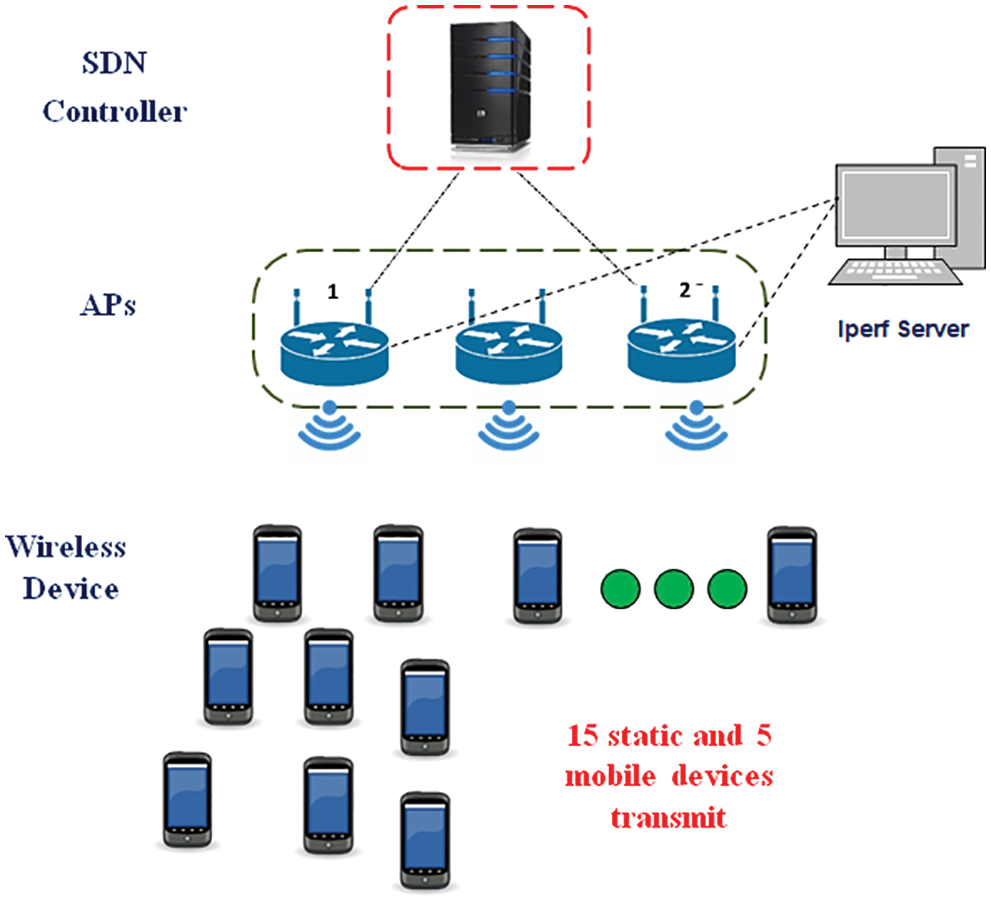
Figure 5: Experiment 2 illustration
Experiment number 3 is designed to study channel occupancy as shown in Fig. 6. WiMA aims to eradicate the concept of dense Wi-Fi networks when a large number of users enter the network and overcrowd the channels. Experiment 3 is set up in a situation where densification has already happened. Densification has caused two APs to share the same collision domain. As WiMA considers the channel load instead of the AP load so the goal is to limit the congestion. Channels 11 and 1 are used to allow two APs to use the same collision domain. WiMA aims to trade-off between the RSSI, AP load, and channel occupancy. If the situation is not handled by load distribution, then channels are re-assigned. 20 wireless devices are used to have equal load distribution among all the APs. The experiment focuses on the assignment and re-assignment of channels so static wireless devices are used and the experiment runs for 10 min.
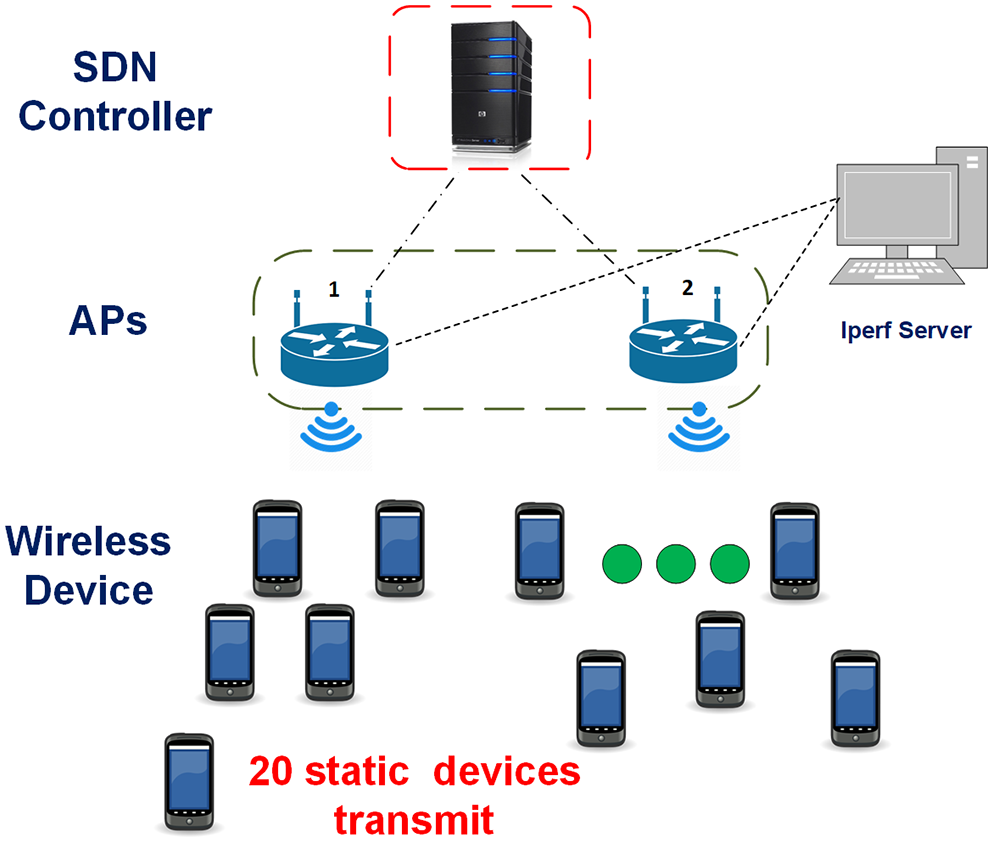
Figure 6: Experiment 3 illustration
WiMA performance in experiment number 1 is compared to Wi-Balance and CD approaches as shown in Fig. 7. The performance gap is bigger when the load in the network increases. As the load is distributed among all the three APs, the aggregated throughput is increased especially in phase 2. In phase 2, the congestion has decreased, and more wireless traffic is handled. WiMA has proved to discontinue the use of dense Wi-Fi networks and reduce the cost of extra infrastructure. The overall throughput performance is increased by 47% and 5% when compared to CD and Wi-Balance, respectively, in phase 1. The performance of WiMA throughput has increased to 50% and 10% over CD and Wi-Balance, respectively. Seeing part (b) of Fig. 7, Jain’s fairness index has increased by 22% and 12% when compared to CD and Wi-Balance approaches in phase 1. In phase 2, the difference has excelled by 23% compared to both approaches. Part (c) of Fig. 7 shows the performance evaluation for re-transmission attempts. When the channel occupancy is higher more re-transmission is required as the packets are lost when trying to compete for a free channel. RSSI values play an important role in the re-transmission index as lower RSSI leads to more packet loss and hence more re-transmission of packets. WiMA has proved to reduce the number of re-transmission by almost half. The concept is streamed with the channel occupancy and physical rate as shown in (d) and (f). Wi-Balance sacrifices the RSSI values to use a channel and is reflected by the decrease in the physical rate. On the contrary WiMA by using RSSI values have an increased physical rate by almost 20%.
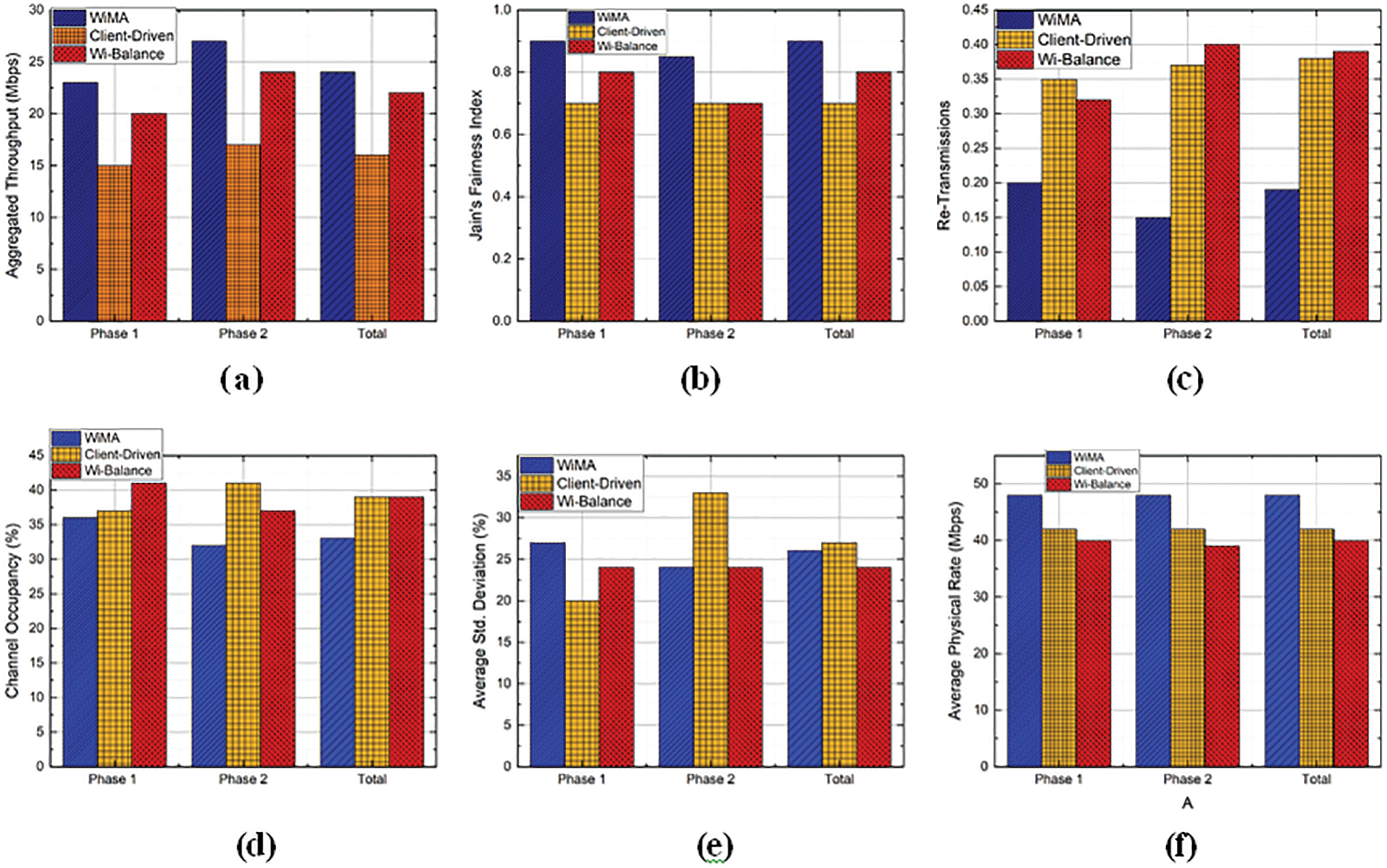
Figure 7: (a) Throughput (b) Jain’s fairness index (c) Number of retransmissions (d) Channel occupancy rate (e) Average standard deviation (f) Average physical rate
The performance evaluation of experiment number 2 is depicted in Fig. 8 when the mobility is taken into account the WiMA shows improved performance. In comparison, the performance of Wi-Balance deteriorates in mobile wireless devices as the RSSI values change. Fig. 8a shows the decreased performance of Wi-Balance as it does not consider re-associations when the RSSI values decrease. In the CD approach, the resource allocation is less efficient which makes the performance not as good as WiMA. The throughput rate of WiMA in comparison to CD and Wi-Balance approach is increased by almost 22%. Jain’s fairness index is also showing increased performance in WiMA as better resource utilization creates fairness of load among the APs. As discussed earlier the number of retransmissions is increased if the RSSI values decrease and the collisions increase. The performance of the re-transmissions is shown in Fig. 8c. Wi-Balance in comparison to WiMA and CD approaches shows poor performance in terms of re-transmission attempts as it does not consider the RSSI values for the association. The channel occupancy rate as shown in Fig. 8, for Wi-Balance is also poor as it handoffs the wireless device to the AP with poor RSSI values leading to disconnection. WiMA has a better performance by almost 85% and 27% when compared to CD and Wi-Balance approaches respectively, related to balance use of channels as shown in Fig. 8e. The channels get saturated and go underused in the CD approach. The channel occupancy rate as shown in Fig. 8f for WiMA is more than CD and Wi-Balance approaches by 24% and 17% respectively.

Figure 8: (a) Throughput (b) Jain’s fairness index (c) Number of retransmissions (d) Channel occupancy rate (e) Average standard deviation (f) Average physical rate
The performance evaluation of experiment number 3 is depicted in Fig. 9. WiMA exhibits good results in terms of channel reassignments. The throughput performance of WiMA is 35% and 15% better than CD and Wi-Balance approaches respectively. The network resource utilization is enhanced in WiMA as seen in Figure (d) where channel 11 is used more efficiently than Channel 1.2 APs in experiment 3 are utilizing Channel 1 so free airtime in Channel 11 allows WiMA to transmit efficiently. WiMA outperforms CD and the Wi-Balance approach in channel occupancy and Jain’s fairness index due to efficient use of the network resource utilization. The fairness index achieved by WiMA is 25% and 10% higher than CD and Wi-Balance approaches respectively.
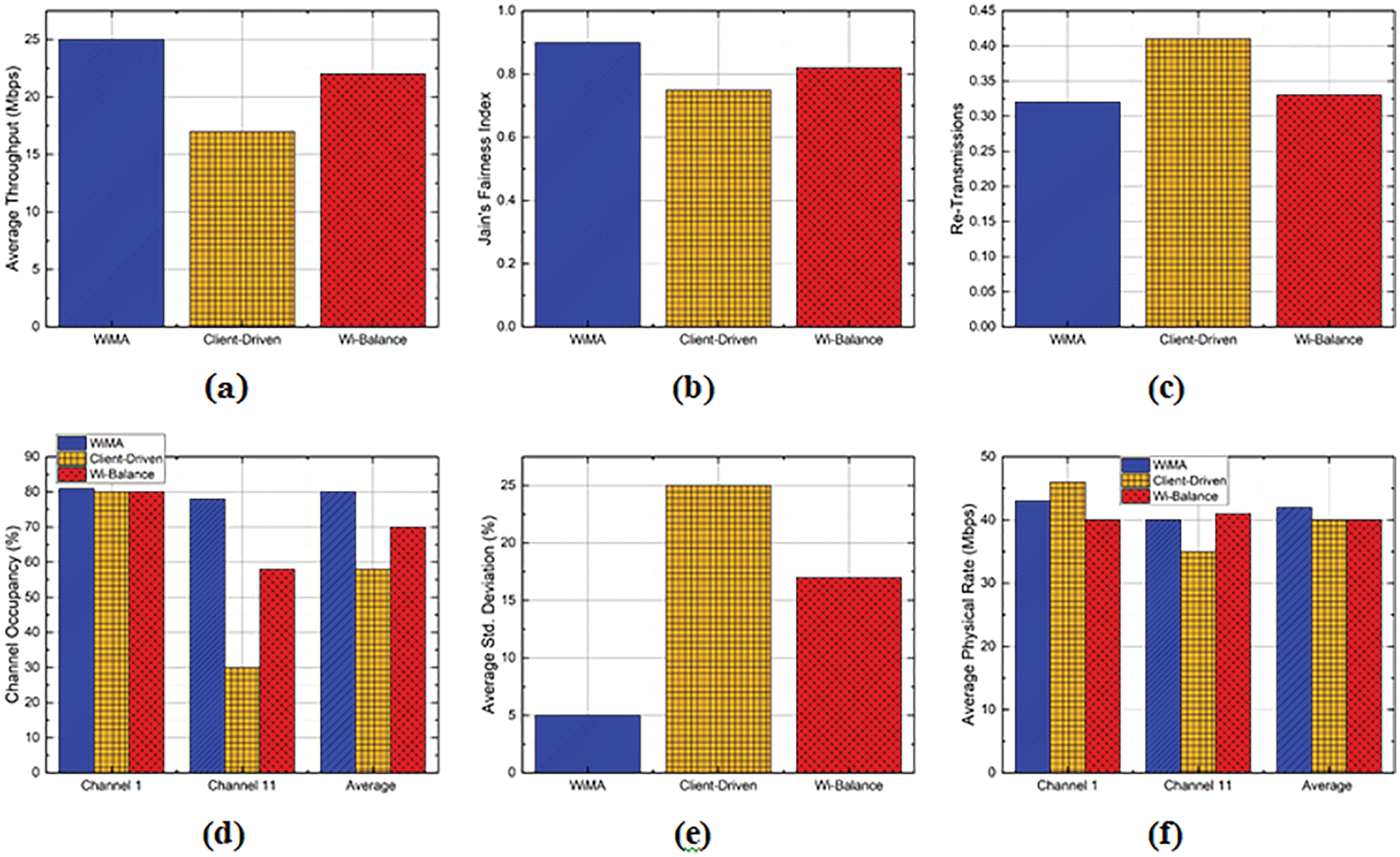
Figure 9: (a) Throughput (b) Jain’s fairness index (c) Number of retransmissions (d) Channel occupancy rate (e) Average standard deviation (f) Average physical rate
Fig. 9c shows that when the congestion in channel 1 is reduced, WiMA reduces the number of re-transmissions by 18% and 3% when compared to CD and Wi-Balance approaches respectively. WiMA aims to have the best trade-off between signal quality and congestion and tries to maintain average performance on each channel as shown in Fig. 9f. Wi-Balance does not take into account the RSSI values leading to lower data rates. CD approach on the other hand does not take into account the load leading to higher collision due to congestion.
The paper presents a novel technique WiMA for enhancing the association mechanism in SD-WiFi. WiMA aims to eradicate the densification of Wi-Fi networks by trading off factors such as RSSI, AP load and channel occupancy. Densification is the common solution in Wi-Fi networks when the number of wireless users increases leading to higher wireless traffic. Densification needs extra infrastructure to be installed and hence the extra cost. The drawback of densification is that, two or more APs share the same collision domain leading to congestion and contention in the wireless medium. WiMA makes efficient use of the underutilized resources so that there is no need for densification. Several network configurations are used to test the performance evaluation of WiMA and hence it is concluded that the need for densification of Wi-Fi networks is not required. WiMA outperforms the CD approach and Wi-Balance approach by 50% and 20% respectively. Jain’s fairness index is also exceptional for WiMA, as better load and channel distribution take place. Channel assignments are only possible when there is less congestion and fewer re-transmissions. Performance evaluation of WiMA shows that before the point where densification is needed, better load and channel optimization is obtained. WiMA also shows the best performance in the scenario where densification is already created and by optimal channel assignments contention in the wireless medium is avoided. We hope to create a Linux based testbed for future implementation of WiMA.
Funding Statement: This work was supported by the “Human Resources Program in Energy Technology” of the Korea Institute of Energy Technology Evaluation and Planning (KETEP), granted financial resources from the Ministry of Trade, Industry & Energy, Republic of Korea (No. 20204010600090).
Conflicts of Interest: The authors declare that they have no conflicts of interest to report regarding the present study.
References
1. S. Manzoor, Y. Yin, Y. Gao, X. Hei and W. Cheng, “A systematic study of IEEE 802.11 DCF network optimization from theory to testbed,” IEEE Access, vol. 8, no. 4, pp. 154114–154132, 2020. [Google Scholar]
2. Z. Chen, Y. Gao, X. Hei and W. Cheng, “Towards QoS-aware load balancing for high density software defined Wi-Fi networks,” IEEE Access, vol. 8, no. 4, pp. 117623–117638, 2020. [Google Scholar]
3. Y. Gao and L. Dai, “Random access: Packet-based or connection-based?,” IEEE Transactions on Wireless Communications, vol. 18, no. 5, pp. 2664–2678, 2019. [Google Scholar]
4. H. Manzoor, N. Ali, M. Sajid and X. Hei, “An SD based technique for reducing handoff times in WiFi networks,” International Journal of Communication Systems, vol. 34, no. 5, pp. 55–75, 2021. [Google Scholar]
5. T. Zahid, X. Hei, W. Cheng, A. Ahmad and P. Maruf, “On the tradeoff between performance and programmability for software defined WiFi networks,” Wireless Communications and Mobile Computing, vol. 18, no. 11, pp. 1–21, 2018. [Google Scholar]
6. M. Sun and H. Qian, “Handover management scheme in SDN-based,” Journal of Communications, vol. 11, no. 3, pp. 1–16, 2016. [Google Scholar]
7. S. Zhang, J. Lan, P. Sun and Y. Jiang, “Online load balancing for distributed control plane in software-defined data center network,” IEEE Access, vol. 6, no. 5, pp. 18184–18191, 2018. [Google Scholar]
8. Z. Chen, Y. Gao and X. Hei, “Achieving load balancing in high-density software defined WiFi networks,” in 2017 Int. Conf. on Frontiers of Information Technology (FIT), Islamabad, Pakistan, pp. 206–211, 2017. [Google Scholar]
9. A. Zanella, “Best practice in RSS measurements and ranging,” IEEE Communications Surveys & Tutorials, vol. 18, no. 21, pp. 2662–2686, 2016. [Google Scholar]
10. N. Feamster, J. Rexford and E. Zegura, “The road to SDN: an intellectual history of programmable networks,” ACM SIGCOMM Computer Communication Review, vol. 44, no. 26, pp. 87–98, 2014. [Google Scholar]
11. L. Suresh, J. Schulz-Zander, R. Merz and T. Vazao, “Towards programmable enterprise WLANS with Odin,” in Proc. of the First Workshop on Hot Topics in Software Defined Networks, NY, USA, pp. 115–120, 2012. [Google Scholar]
12. A. Lara, A. Kolasani and B. Ramamurthy, “Network innovation using openflow: A survey,” IEEE Communications Surveys & Tutorials, vol. 16, no. 6, pp. 493–512, 2013. [Google Scholar]
13. J. Schulz-Zander, C. Mayer, B. Ciobotaru and A. Feldmann, “OpenSDWN: Programmatic control over home and enterprise WiFi,” in Proc. of the 1st ACM SIGCOMM Symp. on Software Defined Networking Research, NY, USA, pp. 1–12, 2015. [Google Scholar]
14. D. B. Rawat and S. R. Reddy, “Software defined networking architecture, security and energy efficiency: A survey,” IEEE Communications Surveys & Tutorials, vol. 19, no. 6, pp. 325–346, 2016. [Google Scholar]
15. Y. Gao, L. Dai and X. Hei, “Throughput optimization of multi-BSS IEEE 802.11 networks with universal frequency reuse,” IEEE Transactions on Communications, vol. 65, no. 31, pp. 3399–3414, 2017. [Google Scholar]
16. H. Farhady, H. Lee and A. Nakao, “Software-defined networking: A survey,” Computer Networks, vol. 81, no. 42, pp. 79–95, 2015. [Google Scholar]
17. S. Jin and S. Choi, “A seamless handoff with multiple radios in IEEE 802.11 WLANs,” IEEE Transactions on Vehicular Technology, vol. 63, no. 25, pp. 1408–1418, 2013. [Google Scholar]
18. A. Majlesi and B. H. Khalaj, “An adaptive fuzzy logic based handoff algorithm for interworking between WLANs and mobile networks,” The 13th IEEE International Symposium on Personal, Indoor and Mobile Radio Communications, vol. 5, no. 6, pp. 2446–2451, 2002. [Google Scholar]
19. A. Zubow, S. Zehl and A. Wolisz, “BIGAP—seamless handover in high performance enterprise IEEE 802.11 networks,” in NOMS 2016-2016 IEEE/IFIP Network Operations and Management Symp., Dubai, UAE, pp. 445–453, 2016. [Google Scholar]
20. M. Derakhshani, X. Wang, D. Tweed and A. Leon-Garcia, “AP-STA association control for throughput maximization in virtualized WiFi networks,” IEEE Access, vol. 6, no. 2, pp. 45034–45050, 2018. [Google Scholar]
21. Z. Ning, X. Hu, Z. Chen, M. Zhou and B. Hu, “A cooperative quality-aware service access system for social Internet of vehicles,” IEEE Internet of Things Journal, vol. 5, no. 4, pp. 2506–2517, 2017. [Google Scholar]
22. Z. Ning, P. Dong, X. Wang, X. Hu and L. Guo, “Mobile edge computing enabled 5G health monitoring for Internet of medical things: A decentralized game theoretic approach,” IEEE Journal on Selected Areas in Communications, vol. 39, no. 6, pp. 463–478, 2020. [Google Scholar]
23. Z. Ning, P. Dong, X. Wang and X. Hu, “Partial computation offloading and adaptive task scheduling for 5G-enabled vehicular networks,” IEEE Transactions on Mobile Computing, vol. 4, no. 1, pp. 1–21, 2020. [Google Scholar]
24. J. Yu, Y. Wang, K. Pei, S. Zhang and J. Li, “A load balancing mechanism for multiple SDN controllers based on load informing strategy,” in 2016 18th Asia-Pacific Network Operations and Management Symp. (APNOMS), NY, USA, pp. 1–4, 2016. [Google Scholar]
25. S. Manzoor, X. Hei and W. Cheng, “Towards dynamic two-tier load balancing for software defined WiFi networks,” in Proc. of the 2017 2nd Int. Conf. on Communication and Information Systems, Toronto, Canada, pp. 63–67, 2017. [Google Scholar]
26. G. Cheng, H. Chen, H. Hu and J. Lan, “Dynamic switch migration towards a scalable SDN control plane,” International Journal of Communication Systems, vol. 29, no. 6, pp. 1482–1499, 2016. [Google Scholar]
27. A. Rego, A. Canovas, J. M. Jiménez and J. Lloret, “An intelligent system for video surveillance in IoT environments,” IEEE Access, vol. 6, no. 2, pp. 31580–31598, 2018. [Google Scholar]
28. S. M. M. Gilani, T. Hong, W. Jin, G. Zhao and H. M. Heang, “Mobility management in IEEE 802.11 WLAN using SDN/NFV technologies,” EURASIP Journal on Wireless Communications and Networking, vol. 17, no. 3, pp. 1–14, 2017. [Google Scholar]
29. C. Y. Lin, W. P. Tsai, M. H. Tsai and Y. Z. Cai, “Adaptive load-balancing scheme through wireless SDN-based association control,” in 2017 IEEE 31st Int. Conf. on Advanced Information Networking and Applications (AINA), NY, USA, pp. 546–553, 2017. [Google Scholar]
30. L. Sequeira, J. L. de la Cruz, J. Ruiz-Mas, J. Saldana and J. Almodovar, “Building an SDN enterprise WLAN based on virtual APs,” IEEE Communications Letters, vol. 21, no. 4, pp. 374–377, 2016. [Google Scholar]
31. A. Rego, S. Sendra, J. M. Jimenez and J. Lloret, “Dynamic metric OSPF-based routing protocol for software defined networks,” Cluster Computing, vol. 22, no. 6, pp. 705–720, 2019. [Google Scholar]
32. M. Yan, J. Casey, P. Shome and A. Sutton, “ÆtherFlow: Principled wireless support in SDN,” in 2015 IEEE 23rd Int. Conf. on Network Protocols (ICNP), NY, USA, pp. 432–437, 2015. [Google Scholar]
33. L. Tao, W. Xiangming, L. Zhaoming, Z. Xing and Z. Biao, “SWN: An SDN based framework for carrier grade Wi-Fi networks,” China Communications, vol. 13, no. 2, pp. 12–26, 2016. [Google Scholar]
34. C. Chen, Y. T. Lin, L. H. Yen and C. C. Tseng, “Mobility management for low-latency handover in SDN-based enterprise networks,” in 2016 IEEE Wireless Communications and Networking Conf., Riyadh, SA, pp. 1–6, 2016. [Google Scholar]
35. I. T. Haque and N. Abu-Ghazaleh, “Wireless software defined networking: A survey and taxonomy,” IEEE Communications Surveys & Tutorials, vol. 18, no. 5, pp. 2713–2737, 2016. [Google Scholar]
36. H. Xu, Q. Li, J. Wang, J. Yang and W. Sun, “Cramer-rao lower bound analysis of RSS/TDoA joint localization algorithms based on rigid graph theory,” Ad Hoc Networks, vol. 103, no. 42, pp. 10–21, 2020. [Google Scholar]
Cite This Article
 Copyright © 2023 The Author(s). Published by Tech Science Press.
Copyright © 2023 The Author(s). Published by Tech Science Press.This work is licensed under a Creative Commons Attribution 4.0 International License , which permits unrestricted use, distribution, and reproduction in any medium, provided the original work is properly cited.


 Submit a Paper
Submit a Paper Propose a Special lssue
Propose a Special lssue View Full Text
View Full Text Download PDF
Download PDF Downloads
Downloads
 Citation Tools
Citation Tools